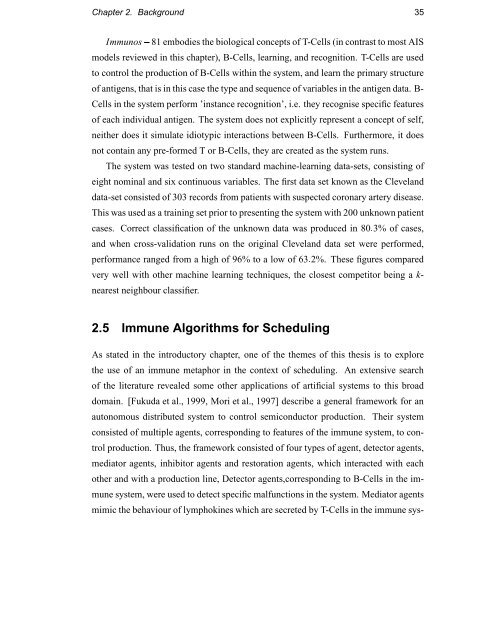Immunology as a Metaphor for Computational ... - Napier University
Immunology as a Metaphor for Computational ... - Napier University
Immunology as a Metaphor for Computational ... - Napier University
You also want an ePaper? Increase the reach of your titles
YUMPU automatically turns print PDFs into web optimized ePapers that Google loves.
Chapter 2. Background 35Immunos 81 embodies the biological concepts of T-Cells (in contr<strong>as</strong>t to most AISmodels reviewed in this chapter), B-Cells, learning, and recognition. T-Cells are usedto control the production of B-Cells within the system, and learn the primary structureof antigens, that is in this c<strong>as</strong>e the type and sequence of variables in the antigen data. B-Cells in the system per<strong>for</strong>m ’instance recognition’, i.e. they recognise specific featuresof each individual antigen. The system does not explicitly represent a concept of self,neither does it simulate idiotypic interactions between B-Cells. Furthermore, it doesnot contain any pre-<strong>for</strong>med T or B-Cells, they are created <strong>as</strong> the system runs.The system w<strong>as</strong> tested on two standard machine-learning data-sets, consisting ofeight nominal and six continuous variables. The first data set known <strong>as</strong> the Clevelanddata-set consisted of 303 records from patients with suspected coronary artery dise<strong>as</strong>e.This w<strong>as</strong> used <strong>as</strong> a training set prior to presenting the system with 200 unknown patientc<strong>as</strong>es. Correct cl<strong>as</strong>sification of the unknown data w<strong>as</strong> produced 80¦ in 3% of c<strong>as</strong>es,and when cross-validation runs on the original Cleveland data set were per<strong>for</strong>med,per<strong>for</strong>mance ranged from a high of 96% to a low 63¦ of 2%. These figures comparedvery well with other machine learning techniques, the closest competitor being a k-nearest neighbour cl<strong>as</strong>sifier.2.5 Immune Algorithms <strong>for</strong> SchedulingAs stated in the introductory chapter, one of the themes of this thesis is to explorethe use of an immune metaphor in the context of scheduling. An extensive searchof the literature revealed some other applications of artificial systems to this broaddomain. [Fukuda et al., 1999, Mori et al., 1997] describe a general framework <strong>for</strong> anautonomous distributed system to control semiconductor production. Their systemconsisted of multiple agents, corresponding to features of the immune system, to controlproduction. Thus, the framework consisted of four types of agent, detector agents,mediator agents, inhibitor agents and restoration agents, which interacted with eachother and with a production line, Detector agents,corresponding to B-Cells in the immunesystem, were used to detect specific malfunctions in the system. Mediator agentsmimic the behaviour of lymphokines which are secreted by T-Cells in the immune sys-









![Unit 5. Switches and VLANs [PDF]](https://img.yumpu.com/34422504/1/184x260/unit-5-switches-and-vlans-pdf.jpg?quality=85)






